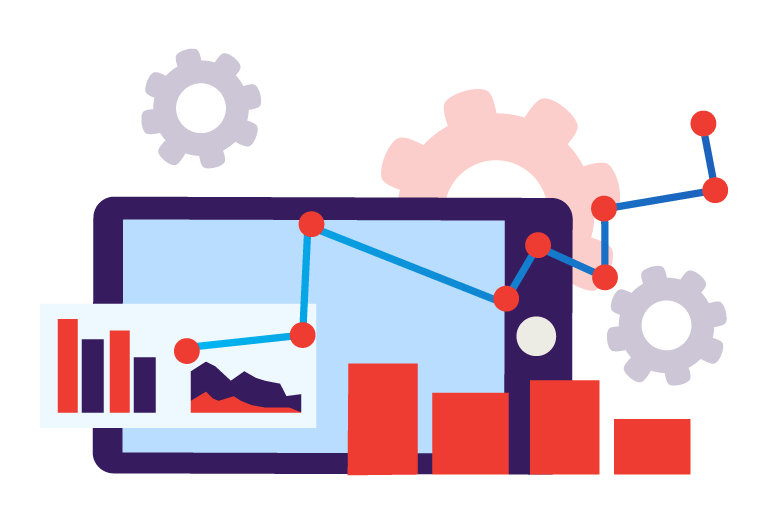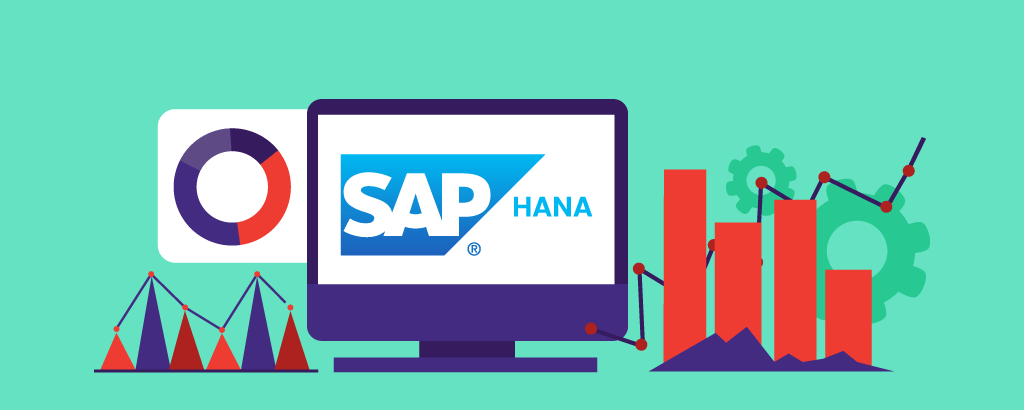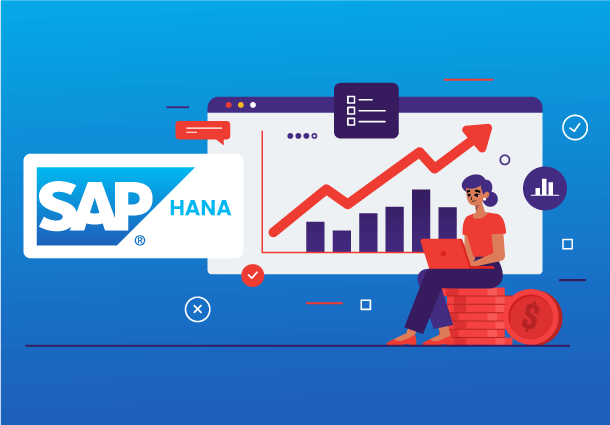Outlining the SAP Business Suite on HANA
There is cutthroat competition on one side and there is an insurmountable amount of disorganized data on the other. It’s an absolute predicament with nowhere to go without the right tool in place.  Enter SAP HANA! Now, you have business intelligence that is capable of shaking up market opportunities you otherwise wouldn’t have discovered. Why? Simply because it performs advanced analytics and machine learning offering real-time data insights. In fact, it’s a turnkey solution to build modern real-time applications. It’s a relational database at heart but relies on in-memory column storage leading to further compression of size and facilitating speedy access, unlike the disk-optimized databases. Since its initial release in 2010, SAP HANA is the fastest-ever growing SAP product with mass adoption by developers, products, partners, and customers. No doubt, people can’t help but follow HANA for the simplicity it provides. Does it sound like a song of praise? Well, you will get an answer to this as we go further down. But now if you are a project stakeholder, product owner, or anyone for that matter trying to solve the puzzle that SAP HANA is, then today that’s where we are getting to. Come along and figure it out!
Enter SAP HANA! Now, you have business intelligence that is capable of shaking up market opportunities you otherwise wouldn’t have discovered. Why? Simply because it performs advanced analytics and machine learning offering real-time data insights. In fact, it’s a turnkey solution to build modern real-time applications. It’s a relational database at heart but relies on in-memory column storage leading to further compression of size and facilitating speedy access, unlike the disk-optimized databases. Since its initial release in 2010, SAP HANA is the fastest-ever growing SAP product with mass adoption by developers, products, partners, and customers. No doubt, people can’t help but follow HANA for the simplicity it provides. Does it sound like a song of praise? Well, you will get an answer to this as we go further down. But now if you are a project stakeholder, product owner, or anyone for that matter trying to solve the puzzle that SAP HANA is, then today that’s where we are getting to. Come along and figure it out!
SAP HANA and its Merits!
Incredible success stories have emerged out of SAP HANA implementation. Companies across the world reaped huge benefits from this technology and have made it their personal favorites. For instance, Adidas has managed to boost the speed and supply chain to build a direct relationship with the customers with SAP. This necessarily points to the fact that SAP HANA’s architecture will improve your business performance in manifolds even before you know it. But what are these features that make SAP HANA the unsung hero?
In-Memory Database System
SAP HANA shows a departure in the storage mechanism by using the in-memory database system (IMDS), where the complete data is stored in the main memory instead of the disk storage. Since SAP HANA is a wizard at handling real-time data, there is no other alternative than IMDS while automating social media monitoring, meter reading, and so on. This sort of storage also improves speed than the other where a lag is observed while writing and reading from a file system.
Real-Time Analytics
The use cases of real-time data analysis are many. In various industries, from predictive maintenance to improving worker security, businesses are head over heels for this technology. And SAP HANA’s in-memory database provides an infrastructure for speedier and swift implementation of the data generated. If SAP HANA did not perform real-time analysis, then it would have required a business warehouse phase to generate reports. Data can be gathered in an instant from business apps across SAP solutions, third-party or custom apps, making day-long operations, a cakewalk. It is a big-time advantage for decision-making, hyper-personalization, fraud warnings, and so on. As a result, enterprises implementing this technology saw a massive rise in their ROI by enhancing customer experience.
Columnar Data Storage
SAP HANA’s architecture features columnar data storage that enables speedy read operations and high-performing write operations. Functions like cluster coding, run-length coding, and dictionary coding can be carried out in order to compress data and save memory. Huge tables with bulky updates go best with the columnar storage technique as opposed to the row-based one that fits smaller tables with frequent single updates.
Parallel Processing
The SAP HANA team calls parallel processing “a divide and conquer” strategy by which the workload is divided by engaging in more resources to perform the same action simultaneously. Each task is allocated to different processor cores based on the packet size that is either calculated dynamically or pre-defined. Again, this is one of the SAP HANA benefits that stem from the columnar arrangement of data. The ultimate result of a parallel processing system is the gain of throughput and cut processing time.
The Charm of Web IDE
Using a browser-based integrated development environment (IDE), complex SAP HANA application development is made simple. This adaptable toolkit includes business logic, rich SAP HANA data models, and a wide variety of tools that are specifically created for multi-targeted applications. It is available for both web and mobile platforms. The practical toolbox consists of inspection tools, graphical editors, and SAP HANA artifacts for easy testing and troubleshooting. Developers may quickly create complex SAP HANA applications with this wide range of resources at their disposal, assuring the best possible functionality and performance.
OLAP/OLTP Benefits
SAP HANA also forms a meeting point for OLAP (Online Analytical Processing) and OLTP (Online Transaction Processing) databases combining them into a single structure. This boosts the speed of both these processes, i.e OLAP including data analysis and reporting, and OLTP including tasks like processing orders. As a result, the database footprint is drastically reduced along with a sharp tradeoff in cost.
The long list of SAP HANA benefits does not end here. In the wide sea that SAP HANA is, there is no scope for a full stop, but a comma. Several other characteristics like flexible modeling, strong computation, and zero data duplication have pushed SAP HANA to replace traditional databases within both the hardware and software spheres. It’s also exciting that SAP’s cloud vision and strategy have evolved to finally provide a foundation for SAP’s overall portfolio. That brings us to the buzzword in SAP HANA implementation methodology – the Cloud platform!
SAP HANA Cloud- The One-Size-fits-all Platform?
SAP HANA Cloud is a prime master when it comes to handling your complex data landscape. Just as SAP HANA is known for its simplicity and speed, you can expect the same with the SAP HANA cloud.  Since it’s a cloud-native data management platform it makes the running and expansion of existing applications easy. The HANA Cloud platform works wonders at building customizations serving as a single gateway to access all information by your organization. The different capabilities of SAP HANA include analytics, mobile services, security, transactions, integration, and serving as a portal. These functions are branched into two (i) as a service and (ii) as a platform. In the former role, it assists enterprises to undertake their task of application management. In the latter, it helps retrieve data in real-time from the SAP HANA database. In a nutshell, it stays true to its tag as a PaaS (Platform as a Service). Another significant advantage of this technology is that it enables the integration of existing applications or third-party environments. Now if you are asking yourself whether you need to use SAP HANA Cloud, here are the possible pointers to tally. First, if your business is looking for more connectivity between its various parts, SAP HANA Cloud will connect IoT sensors to the entire ERP landscape. Second, it suits well for mobile app creation and mobile integration for existing apps. Third, you can create GUI to define workflows or use it as a tool or project coordination as well as machine learning using big data services.
Since it’s a cloud-native data management platform it makes the running and expansion of existing applications easy. The HANA Cloud platform works wonders at building customizations serving as a single gateway to access all information by your organization. The different capabilities of SAP HANA include analytics, mobile services, security, transactions, integration, and serving as a portal. These functions are branched into two (i) as a service and (ii) as a platform. In the former role, it assists enterprises to undertake their task of application management. In the latter, it helps retrieve data in real-time from the SAP HANA database. In a nutshell, it stays true to its tag as a PaaS (Platform as a Service). Another significant advantage of this technology is that it enables the integration of existing applications or third-party environments. Now if you are asking yourself whether you need to use SAP HANA Cloud, here are the possible pointers to tally. First, if your business is looking for more connectivity between its various parts, SAP HANA Cloud will connect IoT sensors to the entire ERP landscape. Second, it suits well for mobile app creation and mobile integration for existing apps. Third, you can create GUI to define workflows or use it as a tool or project coordination as well as machine learning using big data services.
Counting the Differences: SAP ECC, SAP HANA & SAP C/4 HANA
SAP HANA
Just as we already discussed, SAP HANA is an in-memory supporting database for both cloud and on-premise applications. It is more than just a database as it performs real-time analytics in developing and deploying applications. You can even call it a backend that runs the SAP landscape.
SAP ECC
SAP ECC or Central Component (ECC) consists of modules for enterprise resource planning that includes finance, HR, logistics, product planning, and customer service clubbed into an individual system that runs on the database of the user’s preference. It offers tremendous flexibility to make sense of your unique business landscape but at the cost of complexity. By 2004, SAP ECC was used interchangeably with SAP ERP. Also, SAP ECC was succeeded by SAP S/4 HANA.
SAP S/4 HANA
Defined as the next-generation business suite, SAP S/4 HANA will personalize user experiences despite the device by natively connecting to IoT, Big Data, business, and social networks- again in real-time just like SAP HANA. It covers a complete range of financial tasks and has rapid data modeling support simplifying data models, user experience, and decision-making business processes and models.
The Effective Convergence: Combining Microsoft Azure with SAP HANA
If you are planning to host your SAP HANA on the public cloud then you have the liberty to choose Microsoft Azure as your data platform. While this choice wholly depends on your business model, it can also turn to your advantage. First and foremost, you are hosting a public cloud which will give you the gains of the latest and greatest infrastructure. It also eliminates the dependencies on-prem solutions by cutting the procurement cycle. And since you are combining this public cloud with SAP HANA architecture, it’s a bonus at a single stroke.
SAP HANA on Azure: Best Practices to Consider
Remember that you are trying to couple two technologies that have their own unique characteristics. While Azure is self-provisioning, SAP HANA’s workloads are extremely performance sensitive. I prefer you move forward by understanding what your SAP HANA needs on Azure. The best way to do this is to gather instances like computing, storage, and networking used by HANA. Apart from this, you can also:
- You can set real-time alerts via emails.
- Automate all SAP HANA workflows on Azure.
- Create a space for global visibility across all systems.
SAP Hana Benefits For Business
With all the nitty gritty discussed, there’s no doubt that SAP HANA is certainly going to be a game changer for those who make use of it. Of all, fast and real-time access through columnar storage is the most significant one. With this feature, everything from transactions to managing analytical applications can be done seamlessly. SAP HANA’s Express edition is open and free calling for a zero risk first-handed development experience with SAP HANA. Now, talking of industries, three primary industries can revamp the way they work with data by integrating SAP HANA. First, car manufacturing companies can keep track of the market demands and trends with real-time analytics to equally challenge their competitors. Second, biotech research companies can free up their time to conduct research by handing over maintenance and monitoring to the SAP HANA platform. Third, construction industries can process massive amounts of data with SAP HANA design & development to channel them according to customer needs.
Strengthen your business with Pattem Digital’s SAP HANA solutions!
With Pattem Digital’s SAP HANA services, you prepare your applications to hit live production faster than ever. It doesn’t matter if your applications are on-premise or cloud, your SAP software at our hands will be packed with the tools, features, and functionality needed to maximize your market value. Be it customizing, extending, or enhancing your goals, we walk by your side in every process from development to production. Contact us for more information!


